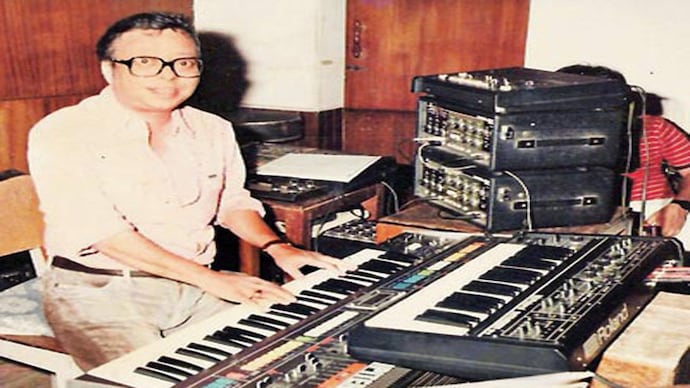RD Burman's top 14 sound improvisations in music direction
Lovers of Hindi film music have been entertained over the years by music director RD Burman's songs. Popularly known as Panchamda, the music maestro brought several innovations to background music in Hindi movies.


Lovers of Hindi film music have been entertained over the years by music director RD Burman's songs. Popularly known as Panchamda, the music maestro brought several innovations to background music in Hindi movies.
Here are 14 top sound improvisations, among several others, to listen and acknowledge. The background music, particularly, in each of these videos, gives an idea of the range of Burman's improvisations.
1) Burman realised very early in his career that he did not have the voice of a playback singer for Hindi movies. But that did not deter him to bend his vocal chords to suit the need. He made the gruffed-voice modulation his trademark. The most popular examples are the songs: 'Mehbooba' from Sholay, the medley of 'Tum kya jano' from Hum Kisise Kam Nahin with flanging, 'Samandar mein' from Pukar, and the prelude in 'Duniya mein' from Apna Desh.
2) For the 'Mehbooba' score in Sholay, he blew into beer bottles to create a unique rhythm.
3) For 'Chura liya' (Yaadon Ki Baraat) he created the tinkling sound from cups and saucers.
4) He had unconventional ways to generate rhythm, one of them being his music assistant Maruti Rao's back, which he patted to create the rhythm for the song 'Raat gayi, baat gayi samjho' from the movie Darling Darling.
The rhythm you hear in this number from the movie Charitraheen was achieved from the clacking sound that Burman played on an inverted timpani, or a kettledrum. The song: 'Teri meri yaari badi purani'.
5) This is brand Panchamda written all over. He introduced rhythm through the way we breathe, pant and laugh. The song: 'Duniya mein logon ko' from Apna Desh (1972) starring Rajesh Khanna and Mumtaz.
Background singer Asha Bhosle's laughter became the rhythm in 'Ye naina yaad hai' from Manzil Manzil (1984). The harmonica tune in this song was inspired by the movie Once Upon A Time in the West.
6) Burman made singer Annette Pinto gurgle to produce the background score in Satte Pe Satta. Listen to the background score here:
7) Rubbed sandpaper and knocked bamboo sticks to give a running train's effect: 'Hoga tumse pyara kaun' from Zamane Ko Dikhana Hai (1981).
8) The sound of a scraping comb came from a guiro, a Latin American scraper made of metal. Burman used this sound (the sound: ) to create rhythm for 'Mere saamnewali khidki' mein from Padosan.
9) He was arguably the first music director to combine semi-classical Hindustani music with guitar strokes. In, 'Raina beeti jaaye' from Amar Prem (1971), he combined santoor and guitar. In the 'Chingari koi bhadke' prelude from the same movie, Panchamda deployed the same technique.
Raina beeti jaaye:
O maajhi re:
Burman also used 12 strings semi-electric guitar coupled with a twang effect to give an extraordinary sound associated only with the music director. The song: 'Tujhse se naraz nahi' from Masoom (1983).
This technique was also used by Kalyanji Anandji in the prelude in Don (1978) 'Yeh mera dil pyaar ka diwana'. Black Eyed Peas, in their track 'Don't phunk with my heart', used the same prelude.
10) He applied the sounds from tabla, essentially an instrument of rhythm, for the purpose of both melody and rhythm: 'O maanjhi re' from Khushboo and 'Tere bina jiya jaaye na' from Ghar.
11) In the superhit song from Aamne Saamne (1982), he brought out sounds that had a vocal-harmoniser and bubble-burst effects in 'Tu main ban gaya'.
12) Once he derived his music from the sounds that beggars make while doing their rounds and shepherds make while grazing their cows, according to Nitin Shankar, a renowned percussionist and chief rhythm assistant of Panchamda. Manzil Manzil (1984) song...
13) He made his music assistant Ramesh Iyer play guitar with a pen or a small stick instead of regular plectrum. At other times, he made Iyer play a set of different sets of guitars, one after the other for a particular number.
14) He used an electric sitar with flanging effect () for 'One, two, cha cha cha' from Shalimar (1978) and 'Tum kya jano' from Hum Kisise Kam Nahin.